
Hmm, I feel like I’m forgetting something.
OK, where to begin?
These thoughts will sometimes race through my head when I’m sitting down to focus on social media time. I’ll fire up Twitter and Facebook and Buffer and want really bad to ensure that I’m covering all my bases and spending time in the best way possible.
And on the good days, I’m right into the groove where I know exactly what to do next and what are the most important tasks that need to get done.
The difference for me is with making a checklist for my social media activities.
I’m happy to share with you all of the tasks I have on my checklist at Buffer and also the ones that social media managers around the Web have on their daily, weekly, monthly checklists. And if I’ve left out a favorite to-do item of yours, I’d be so grateful to hear from you in the comments!
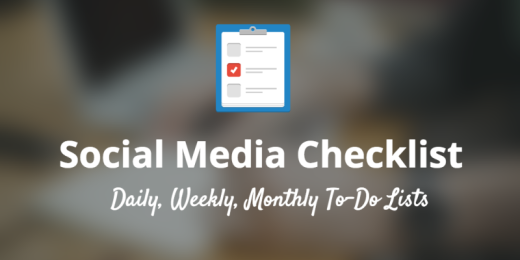
A Daily, Weekly, Monthly Social Media Checklist
We’ve found before that social media managers have a full-time schedule getting all their many tasks accomplished. As you might see in the below checklists, there’s lots to do!
I’ve broken it down here into a daily checklist, a weekly checklist, and a monthly checklist as some of the activities vary in their frequency and need. Feel free to adapt any of this to suit your specific needs (here’s a free template that you can copy and edit).
Keep reading for lots more info and explanation on each of the checklist items you see here!
Daily
- Reply to everyone
- Check your mentions
- Monitor social media for keywords and phrases
- Schedule your updates for the next day
- Check out other social media profiles
- Curate content to share
- Advocacy: Make it easy for your team to share
- Engage with MVPs
- Follow back those who follow you
- Connect with one new person
Weekly
- Check your stats
- Engage with influencers
- Engage with partners
- Weekly goals check-in
- Hold a strategy session
- Attend events—chats, hangouts, etc.
- Update your social media ads
Monthly
- Perform a social media audit
- Goal-setting
- Come up with new experiments
- Plan ahead for the next month or more
The Daily Social Media Checklist
1. Reply to everyone
If you can reply to everyone who engages with you on social media, you’re doing better than 75 percent of brands on social media.
Some reports, like this one from Sprout Social, have found that five in six messages that need responses are not answered by brands. The inverse, of course, is that only one in six messages get an answer—that’s just 17 percent!
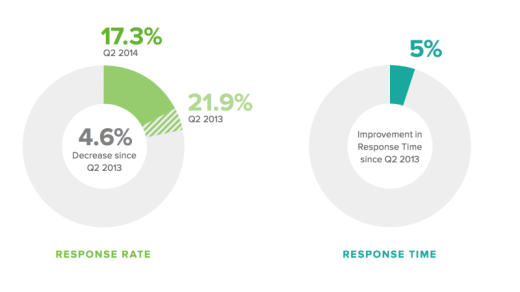
So first and foremost—and on those days when there’s just tons going on, perhaps the most important to-do item of the day and the one we’d recommend for sure making time for—reply to everyone. Reply as quickly as you can, given all else you have happening.
I like this line from AdWeek:
Ignoring customers on social media is similar to ignoring the phone ringing when they call your help centers.
Here are some of our best tips for quick and thorough replies:
- Set up push notifications on your mobile device
- Set up email notifications (with an IFTTT recipe notification if you’d like)
- Use a desktop app like Tweetdeck or other
- Use software like SparkCentral (for Twitter, where response time is paramount)
- Filter customer service to customer service
2. Check your mentions
One layer deeper into replying to everyone (and quite closely related to it) is checking your mentions—any time someone reaches out directly to you on social media.
There are a few quick and easy spots to visit to find these:
- Here’s where to look on Twitter.
- Here’s where to look on Facebook—you can replace the “bufferapp” here with your page name: https://www.facebook.com/bufferapp/notifications/
- Here’s where to look on LinkedIn—you can replace “buffer” with your company name: https://www.linkedin.com/company/buffer/notifications
- Here’s where to look on Google+
As far as the best frequency here, I tend to check my mentions once per day, which I’ve found to be a good flow for my personal brand. The Buffer team, on the other hand, we check our mentions constantly throughout the day on Twitter, using SparkCentral, and in morning and afternoon drivebys of our other social media channels.
3. Monitor social media for keywords and phrases
First off: How do you monitor? There are some neat ways we’ve found to use things like saved Advanced Searches in Twitter, for instance. And we gain a lot of value out of tools like Mention, which feature really robust Google-Alerts-like options for tracking mentions everywhere.
Then as a followup to the how, here’s the what: This great list from Courtney’s post on social media monitoring covers many of the basics of what to monitor on social media.
Brand or company monitoring
- Your name or your brand’s name (e.g., Buffer)
- Any variations of your brand’s name (e.g., Buffer and bufferapp)
- Potential misspellings of your brand’s name (e.g., bffr, bufffer)
- Names of the most active/visible members of your company (e.g., Joel Gascoigne, Leo Widrich)
- Mentions of specific campaigns you’re running (e.g., #bufferchat, #bufferpodcast)
- Your catchphrase, slogan or tagline
Industry or topic monitoring
- Key words or phrases that describe your industry or interest (For example, at Buffer I might want to monitor for key phrases like “social media sharing,” “social media posting” and “social media automation” to start out)
- Key words or phrases related to or complementary to your industry or interest
- Frequently used industry hashtags
I quite like this idea from Sprout Social also, where you use social media monitoring to discover potential new customers for your product.
Monitor for mentions of keywords that indicate that someone is looking for a product similar to yours.
In our case at Buffer, this could be someone who’s searching for “scheduling social media” or “social media management” tools.
4. Schedule your updates for the next day
Schedule your updates ahead of time is perhaps our number one time-saving tip for social media. I’ve personally felt such great freedom and productivity from batching the creation of social media updates into one window of time each day.
When it comes to the amount of what to post, we’re grateful for the research and advice that others have put together on ideal frequency of all the social networks.
Here are some best practices. I’d highly encourage you to test and experiment with what works best for you!
- Post three or more times per day on Twitter
- Post 2x per day on Facebook
- Post 1x per day on LinkedIn
- Post one to two times per day on Instagram
- Post five or more times per day on Pinterest
- Post two or more times per day on Google+
The timing of publishing these posts is another great one we’ve enjoyed researching. I really enjoy this infographic from SumAll that does a nice job summarizing some of the best practices out there:

5. Check out other social media profiles
We’ve gained so much inspiration from the work of others that it’s become a regularly-scheduled part of the day to head out and see what folks are trying on social media.
This can be as straightforward as visiting a handful of favorite profiles—either some industry titans, some peers in your field, some influencers, or some members of your audience.
On Twitter, this can be done quite quickly with a daily visit to one or more Twitter lists. We’ve come up with lots of ideas on how to create these lists. My personal favorite—and one I try to visit every day—is the list of my Buffer teammates.
On Facebook, you can add other pages to your Insights reports. To do so:
- When logged in as the page admin, click Insights from the top of your Facebook page.
- Scroll to the bottom of the Insights page, and you’ll see the “Pages to Watch” section.
- Click the blue button to Add Pages.
Here’s a sample of what our “Pages to Watch” looks like at Buffer:

6. Curate content to share
Part of a social media sharer’s day is likely to include finding fantastic content to share.
We’ve found this to be an area where we’re okay investing a good chunk of time in order to find truly helpful, high-quality content to pass along to our audience. Many sites excel in personalized recommendations and hand-picked stories, and we’re grateful to include many of these in our daily workflow.
Here’re a few favorites:
Nuzzel

Nuzzel is another one of the “news from your friends” apps, letting you connect your social profiles in order to surface the stories that your circles are sharing. A few neat features of Nuzzel include:
- Not only news from friends but also news from friends of friends
- A list of replies and tweets referring to the top content shared by friends
- A boomerang feature: stories that might have slipped your attention
Panda
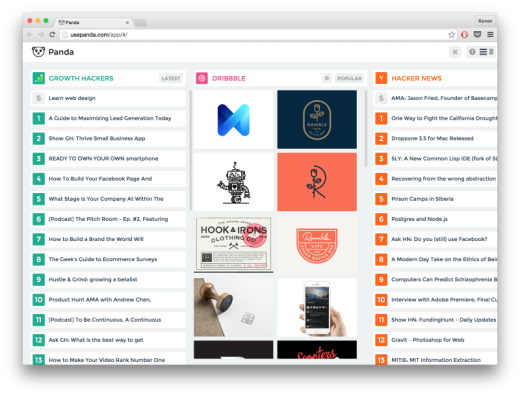
The site collects the top stories and visuals from some of the best communities on the Web and delivers the content in an easy-to-browse layout (or via email, if you’d prefer). You can cycle among a handful of different sites without ever leaving the Panda homepage.
- Hacker News
- Growth Hackers
- Designer News
- Sidebar.io
- Product Hunt
- Lobsters
- Dribbble
- Behance
- Awwwards
Plus here are some more content sources that we’ve found to be great options as well:
7. Advocacy: Making it easy for your team to share
Some of your biggest fans and promoters are likely the people you work with!
LinkedIn found that employees are 70 percent more likely to click, share, and comment on an update than a typical LinkedIn user.
This brings up the idea of advocacy: Encouraging your team to share your content and advocate for your brand.
In practice, this can be as simply as adding a daily checklist item of emailing the team with a new blog post of yours or recommending a tweet to RT or favorite. Further, we’ve made it possible to suggest content to your teammates from within Buffer, which make this level of advocacy even smoother.
Here’s more, if you’re at all interested:
8. Engage with MVPs
Come up with a list of MVP fans or followers, or key people who regularly evangelize your brand. This could be a list of top users, influential people in your industry, folks you’d love to get to know, etc.
Focusing on brand advocates is a popular way to go here, as you can multiply yourself to a degree by encouraging others to share about you. MailChimp co-founder Ben Chestnut has a great way of explaining and showing this process of flipping the funnel upside down:

What this might look like in practice:
- Creating a spreadsheet of MVPs with a column for the last time you made contact
- Marking MVPs within your social media management tool (we have a VIP tag within SparkCentral)
- Setting up a tickler file so you’re reminded to followup with MVPs
9. Follow back those who follow you
On most all social networks, you have a chance to reciprocate a follow and to really make someone’s day!
I follow a bit haphazardly on my personal accounts, so I’ve found lots of inspiration from others in the disciplined way they go about adding this task to their daily to-dos. There are a couple different strategies I’ve noticed with this one:
1. Follow everyone!
Return the favor for all those who follow you on social media. This can be quite straightforward on sites like Twitter and Instagram. For other networks, you can add people to circles on Google+, accept all connections to your LinkedIn, and follow a user or an individual board on Pinterest. On Facebook, pages can “like” other pages.
2. Follow those who fit with your focus or niche
Some people and brands choose to follow a bit more strategically by connecting with those who share common interests. With this, you can browse through a new follower’s bio or timeline to see if their social presence meshes with yours and then decided whether or not to return the follow.
Crowdfire (Twitter/Instagram) and ManageFlitter (Twitter) are two really useful tools for finding people to follow back and for removing any followers who are no longer a fit.

10. Connect with a new person
Similar to some of the other daily to-dos here on the checklist, connecting with someone new can fall in quite smoothly with re-following, replying, and engaging.
The idea behind this item is to practice making one-to-one connections with the people in your audience, welcoming new followers with a personal message or reaching out to someone you appreciate or admire.
And there are some fun ways to do this quickly and easily: Say hi, share a GIF, or go the extra mile with some surprise and delight.
The team at Social Rank wrote about the surprise and delight element, going as far as creating campaigns around the strategy (and highlighting some really cool examples).

The Weekly Social Media Checklist
1. Check your stats
Some people enjoy checking stats on the daily, which is great!
We’ve found for us personally at Buffer that stat-checking is something that fits a bit better on a weekly basis—we can focus on creating and engaging every day and then take a step back to analyze once the week is over.
(One way that’s been helpful for me to think about this is by numbering each week. So for instance, we’re in Week 35 right now. The website whatweekisit.com is really helpful for this.)

In terms of what to check when it comes to stats, there are so many, many options.
We’ve shared a bit about an introduction to social media stats, as well as a weekly social media report you can create for sharing with your boss, client, or team.
I also really like this tip from Finola Howard:
Measure what’s worked. Note your best-performing posts in a spreadsheet or other file so you can reference later as you hone your content.
What makes for a best-performing post? That can be totally up to you, depending on the stats that matter to you. I’ve found that “best-performing” can often be quite easily seen by checking into the stats in my Buffer dashboard and noting how many clicks and reshares an update got, plus how many people it reached.
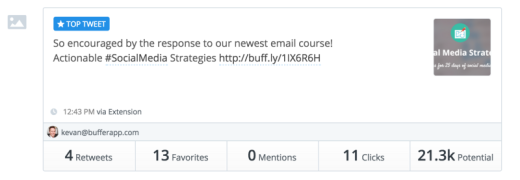
2. Engage with influencers
Many of the daily checklist items involve engaging with your audience. This weekly to-do encourages you to reach out to those outside your circle, particularly any influencers in your industry or niche.
Influencers would typically be those with either a large following or a verified status or an important role at a significant company.
In the past, I’ve identified a few people who I was keen to connect with, added them to a Twitter list, then went about the weekly task of checking out their updates and engaging when appropriate. The goal, ultimately, is to build a relationship and connection—and in a lot of cases it works, if given time.
3. Engage with partners
Similar to the above, engaging with partners involves staying in frequent connection with your fellow brands and friends—in our case it might be some sister SaaS tools like Moz, Unbounce, Feedly, or Pocket.
It’s great to foster these good relationships with peers and partners so that you can continue to collaborate and help each other out as you grow.
4. Weekly goals check-in
How are you doing on your goals? (Much more on goal-setting in the Monthly section below.)
Often times, along with checking your stats on a weekly basis, you can quickly peek at how your stats fit with the goals you’ve set for social media. Here’re a couple of ways we do this at Buffer:
1. Per-post basis
I know that we’ve got a certain benchmark in mind for a successful post, so I’m able to quickly see if we’ve reached that goal by peeking at the per-post stats (for instance, one benchmark is 200 clicks per tweet).
2. Longer-term goals
At other times, we’ll set a bigger goal to aim for over time, and we’ll use what’s called a waterfall graph to chart our progress.

All credit to the team at HubSpot for turning us onto this cool idea. If you’re keen to make a waterfall graph for yourself, here are the instructions:
- Make a copy of our waterfall template here.
- Set a long-term goal for the month (or longer)
- Divide that goal by how many days you have between now and the goal’s end (alternatively, we’ve also done this by weeks)
- Fill out the spreadsheet with your goals and data—the built-in formulas to the bulk of the work here—and add your new traffic/numbers each week to see the graph grow!
5. Hold a strategy session
This one fits with our value of making time to reflect. I’ve found that I can quite easily get heads-down into the day-to-day tasks of social media, and it’s always so refreshing to take a step back and see our social media strategy from a higher level.
Some neat exercises here could be reviewing what went into your social media marketing plan in the first place, i.e. your goals and purpose behind social media. Or answering some of these questions:
- What do we hope to achieve with social media?
- Are we on the right networks to connect with our audience?
- How does our voice/tone convey our brand?
- In what ways can we be most helpful to those we serve?
At Buffer, we’re getting into the pattern of a weekly visioning sync on some of these higher-level ideas, and it’s felt great to be able to spend focused time making reflection a priority in this way.
6. Attend events – chats, hangouts, etc.
Often times, social media events will occur on a weekly basis—Twitter chats, Google Hangouts, and the like.
We run our weekly #bufferchat every Wednesday at 9:00 a.m. Pacific.
We enjoy participating in the weekly #CMGRHangout (for community managers) every Friday.
In terms of finding a chat like these to participate in, Nicole put together a great list of possible places to look:
- Chat Salad is a great place to find chats that are currently happening or taking place in the near future.
- Tweet Reports also has a great listing of Twitter chats.
- Twubs, a website where you can register a hashtag, has an easy-to-read and thorough listing of chats.
- This huge Google doc spreadsheet includes hundreds of Twitter chats.
7. Update your social media ads
Depending on the depth of your commitment and involvement in social media ads, this one could easily be a daily to-do item. If you’re running just a few ads, then weekly could be a good frequency to start with. Check and refresh your ads. Keep the ones that are working. Iterate on the ones that aren’t.
We covered some introductory ground with our social media ads experiments on Facebook, and the comments on the post—like the one below from Lucie—are super helpful in explaining how to know what’s working and what to check on a regular basis.

The Monthly Social Media Checklist
1. Perform a social media audit
With a monthly social media audit, you can look for
- Any updates needed to the profile picture, cover photo, description, or bio for your accounts
- The frequency with which you’ve been publishing to each place
- The growth in followers
- Referral traffic from a network back to your site
- Average clicks and reach for your updates
We’ve placed all this into a spreadsheet that we use to check in with things on a monthly basis. We’d be happy to share the template with you if that’d be helpful for your workflow!
Here’s the social media audit template that you can copy and use.
2. Goal-setting
There’re lots of different ways to go about goal-setting, as highlighted in this neat chat between Tim Ferriss (who enjoys setting goals) and Leo Babauta (who doesn’t).
I find that I fall somewhere a bit in the middle, where I really enjoy having production goals to aim for (publish four blog posts per week, launch a new thing every month) instead of end goals (get to 20,000 followers, have 1 million visits to the blog).
How does goal-setting look for you?
When it comes to social media goals, we wrote in the past about seven goal-setting strategies that could be helpful as you approach this monthly task of finding goals for the future. Here are the seven:
- S.M.A.R.T
- Locke and Latham’s
- OKRs
- BSQ
- BHAG
- Growth Hacker goal-setting
- Intriguing metric
3. Come up with new experiments
In the list of goal-setting strategies above, the last one—intriguing metric—is one that we’ve found quite helpful for us here at Buffer as we think about coming up with new experiments for social media.
The process for doing so involves fitting our metrics into one of four buckets (HT to KISSmetrics cofounder Hiten Shah for his advice here!):
- High traffic, low conversion
- Low traffic, high conversion
- High traffic, high conversion
- Low traffic, low conversion
The first two buckets are the ones where you find the biggest opportunities for growth and experimentation. Bucket No. 3 isn’t half bad either. Bucket No. 4 is best to be left alone.
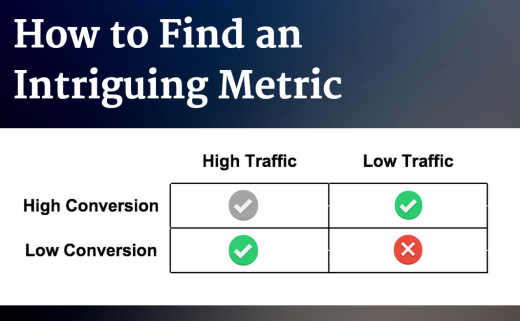
4. Plan ahead for the next month or more
This one fits nicely in with the “time to reflect” value and focus of the weekly strategy sessions. In fact, planning ahead on a monthly basis could happen alongside weekly visioning as well.
With planning, you can both brainstorm strategies for the coming months and get granular with setting up an editorial calendar and charting upcoming campaigns.
The editorial/content calendar idea in particular is one that seems to resonate with a lot of folks. This calendar mockup from the team at Twitter is one that gets me particularly excited about planning ahead and getting things on a calendar!
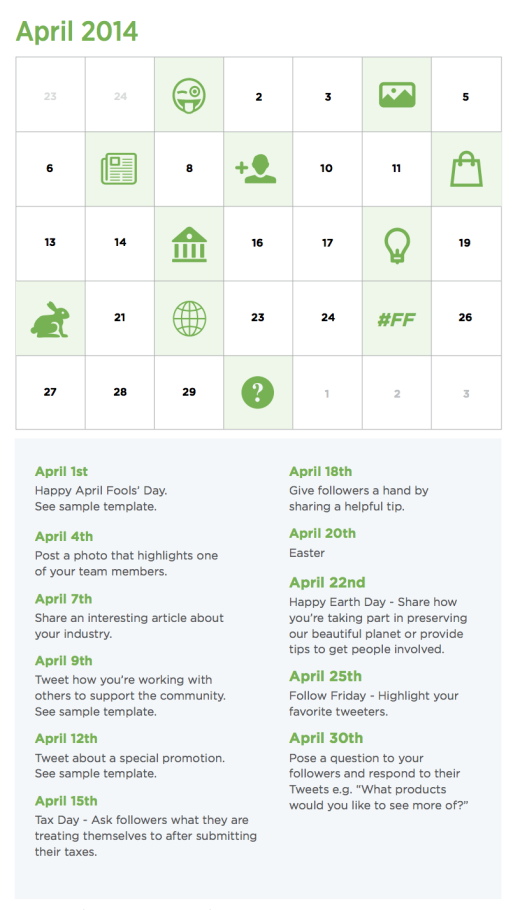
Over to you
What tasks are included in your daily workflow?
Weekly?
Monthly?
It’d be wonderful to learn from you and to pick up any tips you might be open to sharing! I’d love to continue the conversation in the comments, and I’ll look forward to hanging out with you there!
Read Next: The secrets of social media’s most successful sharers
Image credit: Shutterstock, Unsplash, Pablo, IconFinder
This post first appeared on Buffer.
Get the TNW newsletter
Get the most important tech news in your inbox each week.





